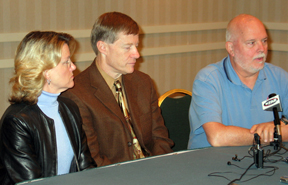 |
Jonathan Richmond, Ph.D., far right, a national biosafety expert and consultant who formerly worked for the Centers for Disease Control and Prevention, answers questions during a media briefing. He is joined by Pat Lenaghan, nurse consultant with the Biocontainment Unit, The Nebraska Medical Center, and Philip Smith, M.D., chief of the section of infectious diseases for UNMC and conference organizer. |
That was the goal of the UNMC-hosted Biocontainment Unit Conference Nov. 8-9.
Organizations that attended included the Centers for Disease Control and Prevention (CDC) in Atlanta, Emory Healthcare, U.S. Army Medical Research Institute of Infectious Diseases (USAMRIID), Offutt Air Force Base, Nebraska Health and Human Services System (HHS), UNMC, The Nebraska Medical Center and the Nebraska Center for Bioterrorism Preparedness.
“We were able to accomplish so much in terms of developing guidelines and standards that the country can use in planning new units,” said Philip Smith, M.D., chief of the section of infectious diseases for UNMC and conference organizer. “We’re very pleased to have developed a consensus on some of the approaches to taking care of patients with highly contagious diseases in this special environment.”
The conference looked at many facets of biocontainment units ranging from safety and care issues and diseases to design and equipment and psychosocial issues.
The country’s largest and only biocontainment unit available to the public is housed at UNMC. The 10-bed unit, a joint venture between UNMC, The Nebraska Medical Center and the Nebraska Department of Health and Human Services System, was unveiled last March by Nebraska Gov. Dave Heineman and CDC Director Julie Gerberding, M.D.
The unit, equipped to care for people exposed to highly contagious and dangerous diseases, was funded with federal money through HHS, with additional contributions from UNMC and The Nebraska Medical Center.
The two other biocontainment facilities in the country are two-bed units at USAMRIID in Ft. Detrick, Md., and the CDC’s unit at Emory University Hospital in Atlanta.
Avian influenza, or bird flu, also was a topic of interest at the conference, as well as at the media briefing.
“The probability of the avian flu becoming a pandemic are still considered to be low, but the consequences, should it happen, are going to be extremely high,” said Jonathan Richmond, Ph.D., a national biosafety expert and consultant who formerly worked for the CDC.
“Certainly if we ever see it jump species and become a disease of humans, we’re then going to be concerned about the fact that people get on airplanes and travel very quickly from one country to another.”
Dr. Richmond was impressed by Omaha’s Biocontainment Unit, noting that the country’s three units are models for future biocontainment units.
Dr. Smith said the 10-bed Biocontainment Unit serves a vital role when the disease is not known. “We may get a disease that we’re not certain about in terms of how dangerous it is or how contagious it is,” Dr. Smith said. “If we have a disease we’re concerned about it, we can isolate it and at the same time buy some time for us to diagnose it and learn what the public health hazard is for a particular agent.”
Pat Lenaghan, nurse consultant with the Biocontainment Unit and The Nebraska Medical Center, said the unit is prepared to take care of patients at all stages – from observation to intensive care. “If someone’s been exposed but not yet ill, we may want to watch them until we have a diagnosis or a positive culture,” she said, “we can put them in the biocontainment unit to safeguard their care.”
Dr. Smith said the unit and staff are prepared to deal with CDC category A agents. The most dangerous, of which are viral hemorrhagic fevers, such as the Marburg hemorrhagic fever recently in Africa, plague, small pox and some of the naturally occurring diseases, Dr. Smith said. “We’re probably more likely to get a disease like avian flu, SARS or monkey pox in our unit than an actual bioterrorist agent,” he said.
Lenaghan said the unit also has special equipment that can be used to safely transport infectious patients. The equipment puts a patient in a protective environment and filters the air before being released.
|
Audio clips Phillip Smith, M.D., comments on: Why there are only 10 Why they’ve been expecting the spread of Avian flu. UNMC’s preparedness for an epidemic. |